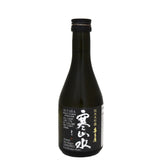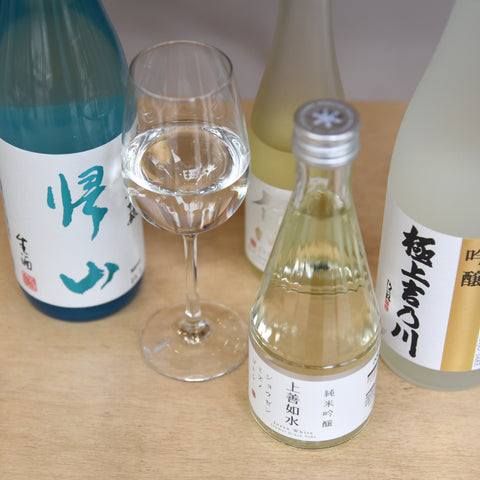 Yume Ikkon rice growing in Fukuoka. Photo by Ikekame Shuzo
Yume Ikkon rice growing in Fukuoka. Photo by Ikekame Shuzo
In 2016, Yoko and I met our friend Anders in Kyushu. It was my first time on the southern most island of Japan (excluding Okinawa), and I absolutely fell in love with the towns we visited: Saga, Kumamoto, and Fukuoka. There is a laid back atmosphere to Kyushu and its people – compared to the hustle and bustle of Tokyo, it’s just much more chill there. In Fukuoka, we were taken on a tour of Yame and its picturesque tea farms and had a lovely lunch around a irori (sunken hearth – nevermind it was boiling temperatures outside). Then, we were off to Kitaya Brewery, known for their sakes and shochus (see the tour on the blog!). Afterwards, we stayed at a lovely ryokan on the Chikugo River. I returned to Fukuoka earlier this year and stayed at that very same ryokan and explored other towns in the prefecture a bit more, as well as the dynamic namesake city, with its signature tonkotsu ramen, gyoza, and the lively yatai (food carts) that pop up nightly around the city center.
As Umami Mart’s Shochu Director, let me say that while Kyushu is known for shochu, Fukuoka also has a grand reputation for its sake production. Koji Umeki of Kitaya Shuzo told me that the oldest brewery in Fukuoka was founded in 1673 and by 1691, there were 613 sake breweries in Fukuoka; today it is home to 59 breweries all over the prefecture. The region’s climate makes it ideal for rice growing (the winters are cold yet dry), and sake brewers have become more committed to use locally grown rice.
“Fukuoka Prefecture is said to be one of Japan's three major sake producers, and was the second largest producer of sake in the country after Hyogo. Not only rice but also water was abundant, the population was large, and there were many workers and drinkers. It was blessed with a location where it was easy to obtain pure energy because there were many coal mines, and because it was surrounded by the sea, it was easy to transport alcohol across the country,” said Tetsuo Yamaguchi, the 11th generation brewer of Yamaguchi Sake Brewery.
In 2003, a strain of sake rice called Yume Ikkon was developed – President Teruyuki Kamachi of Ikekame Shuzo says, “Yumeikkon is a variety developed in Fukuoka Prefecture, and it is low in protein and has a refined taste.” Mr. Umeki of Kitaya Shuzo adds, “It is characterized by large grains, high yield, and is difficult to fall over.” Umeki-san refers to the height of the rice plants – Yamada Nishiki, although the king of sake rice, grows tall and has the tendency to fall over. Yume Ikkon on the other hand does not grow so high, so it is not as susceptible to damage. Tetsuo Yamaguchi adds that the strain is stable and has adapted to the hot Japanese summers.
I’m thrilled to feature sakes this month all made with Yume Ikkon and Yamada Nishiki rice from Fukuoka! One thing is clear about Fukuoka-made sakes: they are crisp and excellent with food. I hope you enjoy them, and even more, I hope you put Fukuoka on your itinerary for your next Japan trip! You won’t regret it.
Kanpai,
Kayoko
Co-Founder, Umami Mart
+++
LEVEL ONE

Niwa no Uguisu Junmai Ginjo 60
Yamaguchi Shuzojo (Fukuoka, Japan)
Seimaibuai: 60% Yamadanishiki + Yume Ikkon, SMV: +3, Acidity: 1.5
Niwa no Uguisu translates to “nightingale of the garden”, and it’s the brand that the brewery is most well known for, winning many accolades. The “60” in the name is in regards to the rice polishing, and they use rice grown right by their brewery. Tetsuo Yamaguchi, 11th generation president of Yamaguchi Shuzojo says this is the sake he will drink at his saigo no bansan (last supper). Bold statement! The concept of this sake, he said, is that you can enjoy it cup after cup, and he always has it in his refrigerator at home. This sake is indeed super crisp yet supple and paired especially well with Estero Gold cheese and canned anchovies on Morrell’s country loaf.

Koji made with Yamada Nishiki rice grown nearby at Yamaguchi Shuzojo
+++

Kitaya Kansansui Junmai Daiginjo
Kitaya Shuzo (Fukuoka)
Seimaibuai: 45% Yamada Nishiki + Yume Ikkon
SMV: +1, Acidity: 1.5
We visited Kitaya Shuzo in 2016, a brewery located in the city of Yama, founded in 1820. Kansansui means “cold mountain water”, fitting since it’s brewed with water from the Yabe River, deep in the mountains of Yame. I recall the lush greenery surrounding the brewery, within a charming country setting. This sake uses a blend of Yamada Nishiki and Yume Ikkon, both grown in the prefecture. “By using multiple rice varieties with different characteristics, it creates a complex flavor. This sake brings out the best of both the aromatic and delicate flavor of Yamada Nishiki and the deep richness and rich flavor of Yume Ikkon.” Enjoy cold with Garrotxa cheese or temaki night.

Washed rice on drying racks at Kitaya Shuzo

Yamada Nishiki rice grown in Fukuoka. Photo by Kitaya Shuzo.
+++
LEVEL TWO

Minogame Muroka Tokubetsu Junmai
Ikekame Shuzo (Fukuoka)
Seimaibuai: 55% Yume Ikkon, SMV: +3, Acidity: 1.4
On a recent visit to Fukuoka, I was able to visit Ikekame Shuzo, a brewery in the town of Kurume. The brewery was founded in 1875 and its president Teruyuki Kamachi is doing some really rad things with his sakes! You may remember that we featured their Kuro Kabuto sake a few years back, which was made with white koji, creating a sake with high acidity. Kamachi-san says, “In addition to brewing sake, people in Fukuoka have been producing shochu for a long time, so I think there are many breweries that use flexible ideas to produce interesting sake.” This sake here is muroka (charcoal unfiltered), made with local Yume Ikkon. You’ll notice flecks of kasu (lees) and Kamachi-san adds, “we use yeast with a mild aroma, and we wanted to preserve the original flavor of moromi.” Enjoy the soft textures of this sake at room temperature in a large ceramic guinomi alongside a charcuterie board with Mt. Tam cheese and Fra Mani salamis. Kamachi himself designed the Minogame (a mythical turtle with algae growing from its shell), an auspicious symbol of longevity.

Chikugo River, flowing near Ikekame Shuzo

Niwa no Uguisu Junmai Daiginjo 45
Yamaguchi Shuzojo (Fukuoka)
Seimaibuai: 45% Yume Ikkon, SMV: +1, Acidity: 1.4
Dinking this sake is like floating upon a fluffy cloud against a bright blue sky. Yamaguchi says it is made with, “soft rice grown only in Fukuoka Prefecture. It is a sake that is full of flavor from the moment you press it – juicy and fragrant.” Well-balanced and elegant, the sake has a crisp entry with a long tail. I loved this cold with bolder, spicier dishes like mapo tofu or cioppino – a luxurious complement to the foods of the colder months.




Comments (0)
There are no comments for this article. Be the first one to leave a message!